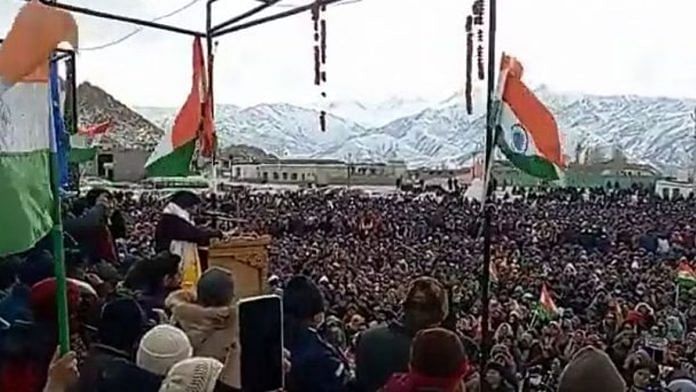Thank you dear subscribers, we are overwhelmed with your response.
Your Turn is a unique section from ThePrint featuring points of view from its subscribers. If you are a subscriber, have a point of view, please send it to us. If not, do subscribe here: https://theprint.in/subscribe/
When Jammu & Kashmir was split into two union territories on August 5, 2019, the streets of Leh, the capital of Ladakh, burst into joy. Five years later, locals are staging violent protests in the same streets, calling for Ladakh to become a state and for tribal status under the constitution’s Sixth Schedule, just like the northeastern states.
Ladakh, which avoids the chaos of mainstream politics, has gained attention lately due to protests and shutdowns.
“Leh chalo,” “Bahaal karo, Bahaal karo (restore).” Rent the air last week as thousands of locals and activists braved bitter cold and a lot of snow to take part in large-scale protest marches.
Traditionally divided along religious lines, the Muslim-majority Kargil and the Buddhist-majority Leh have joined forces for the protests this time.
Leading the demonstrations are the Kargil Democratic Alliance (KDA) AND the Leh Apex Body (LAB). I’ve also witnessed the involvement of Sonam Wangchuk, the winner of the Magsaysay Award and a climate activist, whose life is credited with inspiring the Bollywood hit film 3 Idiots, starring Aamir Khan.
Even the sole Member of Parliament for Ladakh, Jamyang Tsering Namgyal of the BJP, who became well-known for his vehement speech on article 370 in 2019 and who was praised by Prime Minister Narendra Modi, encouraged the center to oppose the land, jobs, and cultural identity of the UT.
Although Ladakh has historically seen rallies against statehood and the constitutional protection of its identity, this is perhaps the largest such event to occur in the region since 2019.
Its timing is particularly noteworthy because it occurs one month before the 2024 Lok Sabha election and in the year that Jammu & Kashmir is expected to hold its first elections in ten years.
Since 2002–2003, the Ladakh district of Leh has been requesting U&T status since it felt disregarded by the J&K government that followed. Thus, the 2.74 lakh people who live in Ladakh were very excited when the state was split in August 2019. Ladakh, which had long grumbled about Jammu & Kashmiri politicians controlling it, viewed the ruling as a step in the right direction toward more autonomy. But the happiness quickly gave way to rage and desperation when the locals realized that Ladakh, which had two MLAs elected to the Legislative Council and four MLAs to the former J&K Assembly, would have no legislature and a lieutenant governor overseeing bureaucrats in charge of the government. Many believed that this would weaken Ladakh’s position in negotiations with the center. J&K, on the other hand, has the choice to establish its own administration and legislature, which would consist of a CM and elected MPs.
Four demands are at the core of the Ladakh protests: statehood, tribal status, locals’ job reservation, and one parliamentary seat each for the districts of Leh and Kargil.
Statehood: People’s fear that Ladakh, now directly governed by the Indian government, will lose its prior protections in terms of land and employment, changing its ethnic demographics, is the root of the demand for statehood.
Residents in ecologically delicate Ladakh believe that in the absence of a legislature, the center would authorize industrial and development projects there without getting their approval.
“Ladakh should be granted statehood for its many merits, including its rich history, geopolitical value, environmental significance, and resemblance to other states in the Northeast. According to a document last year, Ladakh representative groups filed with the Union Home Ministry.
A new state may be established by Parliament in accordance with Article 3. There have been prior cases of Union Territories attaining statehood in Indian history. Goa, the smallest state in India at 3,702 square kilometers, became a state in 1987. At 59,146 sq km, Ladakh is larger than Kashmir.
Tribal status: Ladakh, home to over 97% tribal people, has applied for protection under the constitution’s sixth schedule. The locals worry that now article 370 has been repealed, foreigners may purchase land and vie for employment that were previously only available to Ladakh residents. The sixth schedule, to put it simply, is about protecting the rights of the tribal people and their traditional identity. In actuality, Ladakh’s inclusion in the sixth schedule received the support of the National Commission for ST.
These pieces are being published as they have been received – they have not been edited/fact-checked by ThePrint

